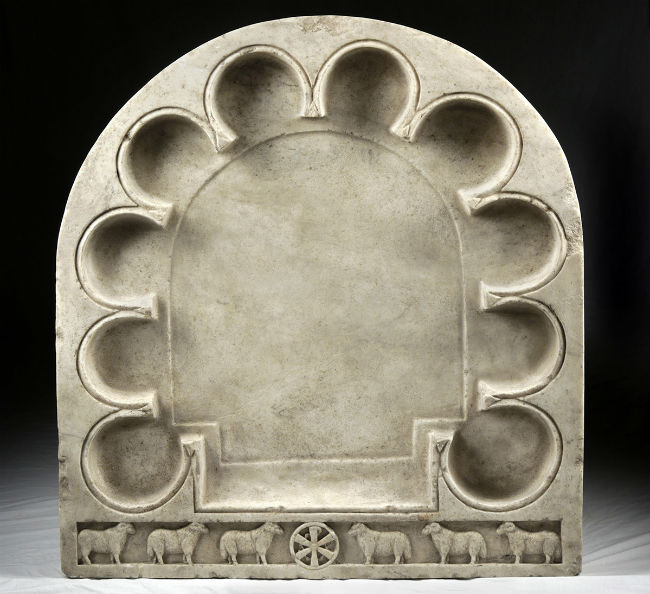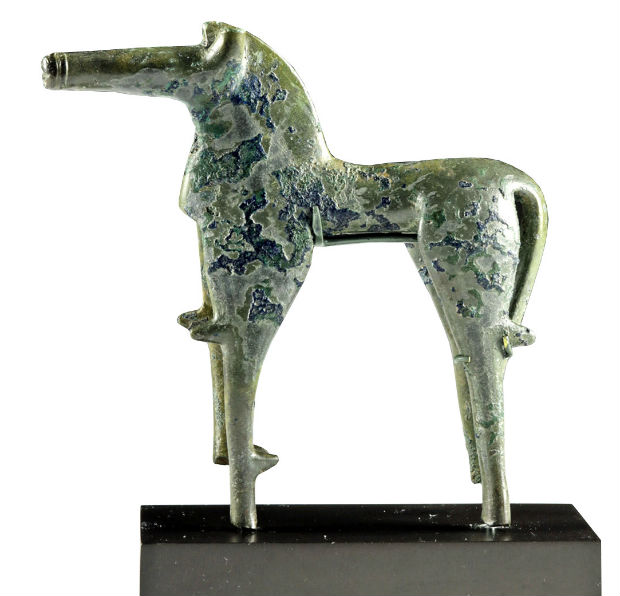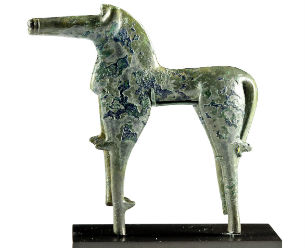
BOULDER, Colo. – Antiquities, ancient and ethnographic art of exceptional quality continue to put Artemis Gallery on the international map as a discerning and trustworthy source for buyers. That message was driven home most recently on Feb. 21 as the suburban Boulder, Colorado, auction house set a new house record exceeding $1.4 million, inclusive of 24.5 percent buyer’s premium and after-sales. Absentee and Internet live bidding was available through LiveAuctioneers.
“We were thrilled to see the amount of bidder interest in fine-quality ancient and ethnographic art, most of which was coming to auction for the first time. Egyptian, Greek and Roman classics, and Asian artworks – all were in high demand,” said Teresa Dodge, managing director of Artemis Gallery.
Leading the impressive list of prices realized was an enormous Early Byzantine (circa A.D. 400 to 600) liturgical table finely carved from a single piece of creamy white marble (above). Its design incorporates 10 carved, lobed compartments around a curved top, as well as a beautiful relief panel with depictions of six sheep flanking a chi-rho symbol, the Greek monogram for Christ. Similar to an example on view at the Metropolitan Museum of Art, this choice antiquity was bid to $105,825.
A wonderful Ancient Greek Cycladic carved marble female figure (below) typical of the sculpture of the mid-2000s B.C. came from the island of Naxos. It was described by Artemis Gallery experts as being of the Spedos variety. Its provenance included a Christie’s London sale and ownership by a private UK collector (1960s). It sold on Feb. 21 for $93,375 against an estimate of $80,000-$100,000.

Among other Greek treasures, a circa-sixth-century B.C. Corinthian phiale, or libation bowl, with a winged siren motif, exceeded estimate at $12,450; and an important Geometric Period bronze horse (below), circa eighth century B.C., possibly Laconian Type, rode off into the sunset for a healthy $31,125.

There were several standouts within the enviable selection of Roman marbles. An incredible carved rendering of a goat’s head, early Imperial Period, circa first century, sold for $43,575.

A detailed portrait bust of the feared and bloodthirsty Emperor Caracalla, created circa A.D. 212 to 217, rose to an above-estimate $28,012.

Probably no other artwork in the sale created as much curiosity as a life-size Pre-Columbian Veracruz culture ceramic figure that is in actuality a functional vessel flute. Fashioned to appear as though it were wearing a headdress, loincloth, bracelets and other adornments, the figure has multiple holes on its body, precisely positioned to create differently pitched sounds. Similar to an example held in the collection of the Art Institute of Chicago, it handily reached the midpoint of its pre-sale estimate, settling at $49,800.

The Asian category was overseen by a gorgeous Gandharan (Pakistan/Afghanistan) stucco figure of a seated Buddha Shakyamuni. The sensitive portrayal of the crown prince of the Shakya Kingdom, with legs crossed as though meditating, went to a new owner for $21,165.

Both dealers and collectors actively participated in the 471-lot auction, Dodge said, with the majority of sales, by dollar value, attributable to international bidders. “We have our own in-house packing and shipping department, which makes a big difference, especially when purchases are being shipped abroad. We sell precious, fragile items and want each object to reach its new owner safely. Our clients have told us time and again how much they appreciate that we do not outsource to a third-party packer.”
“The demand for quality pieces with solid provenance continues to demonstrate how strong the market is,” Dodge continued. “Our bidders know how particular we are about authenticating each object and documenting its provenance to ensure it is legal to buy, own, and if desired, resell. When those factors are in place, it creates bidder confidence.”
Dodge said that on the day following the auction the gallery was inundated with calls from people enquiring about unsold lots they had missed out on. “There is far more demand than supply in the field of high-end antiquities. The interest is only growing. Some of the world’s greatest collections are being built right now,” she said.
[av_button label=’View the fully illustrated catalog with prices realized.’ link=’manually,https://www.liveauctioneers.com/catalog/135593_exceptional-antiquities-asian-ethnographic/’ link_target=’_blank’ size=’medium’ position=’center’ label_display=” icon_select=’no’ icon=’ue800′ font=’entypo-fontello’ color=’theme-color’ custom_bg=’#444444′ custom_font=’#ffffff’ av_uid=’av-86xypad’ admin_preview_bg=”]


